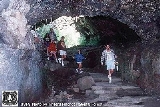
Ape Cave
Encyclopedia
Ape Cave is a lava tube
located in Gifford Pinchot National Forest
just to the south of Mount St. Helens
in Washington state. Its passageway is the longest continuous lava tube in the continental United States, at 13042 feet (3,975 m). Ape Cave is a popular hiking destination with beautiful views of the Mount St. Helens lahar
region. Lava tubes are an unusual formation in this region, as volcanoes of the Cascade Range
are mostly stratovolcano
s and do not typically erupt with pahoehoe (fluid basalt).
The cave was discovered in 1947 by Lawrence Johnson, a logger, when his truck fell into a sinkhole
which opened into the cave. A Boy Scout
troop under the leadership of Harry Reese performed the first exploration in 1950. They named the cave for their sponsor, the St. Helens Apes, a local group made up of mostly foresters.
Lava tube
Lava tubes are natural conduits through which lava travels beneath the surface of a lava flow, expelled by a volcano during an eruption. They can be actively draining lava from a source, or can be extinct, meaning the lava flow has ceased and the rock has cooled and left a long, cave-like...
located in Gifford Pinchot National Forest
Gifford Pinchot National Forest
Gifford Pinchot National Forest is a U.S. National Forest located in southern Washington, USA. With an area of 1.37 million acres , it extends 116 km along the western slopes of Cascade Range from Mount Rainier National Park to the Columbia River. It includes the 110,000 acre Mount St....
just to the south of Mount St. Helens
Mount St. Helens
Mount St. Helens is an active stratovolcano located in Skamania County, Washington, in the Pacific Northwest region of the United States. It is south of Seattle, Washington and northeast of Portland, Oregon. Mount St. Helens takes its English name from the British diplomat Lord St Helens, a...
in Washington state. Its passageway is the longest continuous lava tube in the continental United States, at 13042 feet (3,975 m). Ape Cave is a popular hiking destination with beautiful views of the Mount St. Helens lahar
Lahar
A lahar is a type of mudflow or debris flow composed of a slurry of pyroclastic material, rocky debris, and water. The material flows down from a volcano, typically along a river valley. The term is a shortened version of "berlahar" which originated in the Javanese language of...
region. Lava tubes are an unusual formation in this region, as volcanoes of the Cascade Range
Cascade Range
The Cascade Range is a major mountain range of western North America, extending from southern British Columbia through Washington and Oregon to Northern California. It includes both non-volcanic mountains, such as the North Cascades, and the notable volcanoes known as the High Cascades...
are mostly stratovolcano
Stratovolcano
A stratovolcano, also known as a composite volcano, is a tall, conical volcano built up by many layers of hardened lava, tephra, pumice, and volcanic ash. Unlike shield volcanoes, stratovolcanoes are characterized by a steep profile and periodic, explosive eruptions...
s and do not typically erupt with pahoehoe (fluid basalt).
The cave was discovered in 1947 by Lawrence Johnson, a logger, when his truck fell into a sinkhole
Sinkhole
A sinkhole, also known as a sink, shake hole, swallow hole, swallet, doline or cenote, is a natural depression or hole in the Earth's surface caused by karst processes — the chemical dissolution of carbonate rocks or suffosion processes for example in sandstone...
which opened into the cave. A Boy Scout
Boy Scout
A Scout is a boy or a girl, usually 11 to 18 years of age, participating in the worldwide Scouting movement. Because of the large age and development span, many Scouting associations have split this age group into a junior and a senior section...
troop under the leadership of Harry Reese performed the first exploration in 1950. They named the cave for their sponsor, the St. Helens Apes, a local group made up of mostly foresters.

